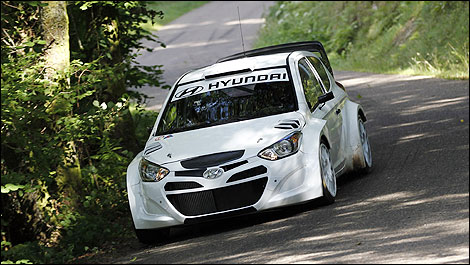Sep
4th
Stay connected Subscribe to our RSS feed
From press release
Hyundai Motorsport's intensive testing schedule continued as the i20 WRC car made its tarmac debut in France, as well as a productive test on the high-speed gravel conditions in Finland.
Test drivers Bryan Bouffier and Juho Hänninen were both in action over a total of ten days with both drivers sharing duties on tarmac before gravel specialist Hänninen assumed control on his home turf.
The latest iteration of the i20 WRC car hit tarmac roads for the first time in the Vosges region of France from August 12 to 16 with the main objective of gathering experience and data on this terrain.
“For our first time with the 2014-spec i20 WRC on tarmac, we adopted a deliberately broad test plan with the main goal of defining the base set-up for that surface,” explained Team Principal Michel Nandan. “We completed good mileage with no major issues, and obtained valuable feedback from both Bryan and Juho, which will allow us to concentrate next on fine-tuning the individual components. Overall, it was a very positive tarmac debut”
From the tarmac test, the team moved to Finland last week to tackle the fast gravel roads and the well-known jumps, which characterise Rally Finland, one of the most technically demanding rallies of World Rally Championship. With local hero Juho Hänninen behind the wheel, the test featured an upgraded version of the 2014-spec of the i20 WRC.
“In Finland we used an evolution of the 2014-spec car, different from the one which we used in France,” added Nandan. “We applied some changes to the shape of the body and during the test we worked on the aerodynamics of the car. The i20 WRC was fitted with a new aerodynamics package and we focussed our efforts in finding a good balance. We wanted to check that all aspects of the car worked properly at high speed, as well as on the jumps, which are extremely demanding. The car can reach extreme acceleration through these jumps so it is essential to study the behaviour of the car and all of its components upon landing. We've also tried different suspension and differential solutions to develop the best set-up for next year's rally.”
With test sessions planned almost every two weeks, Hyundai Motorsport now faces the busiest time of the development phase ahead of its entry into next year's FIA World Rally Championship.
Hyundai Motorsport's intensive testing schedule continued as the i20 WRC car made its tarmac debut in France, as well as a productive test on the high-speed gravel conditions in Finland.
Test drivers Bryan Bouffier and Juho Hänninen were both in action over a total of ten days with both drivers sharing duties on tarmac before gravel specialist Hänninen assumed control on his home turf.
The latest iteration of the i20 WRC car hit tarmac roads for the first time in the Vosges region of France from August 12 to 16 with the main objective of gathering experience and data on this terrain.
 |
| Photo: Hyundai Motorsport |
“For our first time with the 2014-spec i20 WRC on tarmac, we adopted a deliberately broad test plan with the main goal of defining the base set-up for that surface,” explained Team Principal Michel Nandan. “We completed good mileage with no major issues, and obtained valuable feedback from both Bryan and Juho, which will allow us to concentrate next on fine-tuning the individual components. Overall, it was a very positive tarmac debut”
From the tarmac test, the team moved to Finland last week to tackle the fast gravel roads and the well-known jumps, which characterise Rally Finland, one of the most technically demanding rallies of World Rally Championship. With local hero Juho Hänninen behind the wheel, the test featured an upgraded version of the 2014-spec of the i20 WRC.
 |
| Photo: Hyundai Motorsport |
“In Finland we used an evolution of the 2014-spec car, different from the one which we used in France,” added Nandan. “We applied some changes to the shape of the body and during the test we worked on the aerodynamics of the car. The i20 WRC was fitted with a new aerodynamics package and we focussed our efforts in finding a good balance. We wanted to check that all aspects of the car worked properly at high speed, as well as on the jumps, which are extremely demanding. The car can reach extreme acceleration through these jumps so it is essential to study the behaviour of the car and all of its components upon landing. We've also tried different suspension and differential solutions to develop the best set-up for next year's rally.”
With test sessions planned almost every two weeks, Hyundai Motorsport now faces the busiest time of the development phase ahead of its entry into next year's FIA World Rally Championship.
 The latest auto news, reviews, prices, product and vehicle releases.
The latest auto news, reviews, prices, product and vehicle releases.